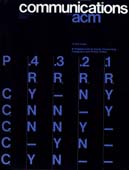September 1974 - Vol. 17 No. 9

Features
A new integration algorithm is found, and an implementation is compared with other programmed algorithms. The new algorithm is a step-by-step procedure for solving the initial value problem in ordinary differential equations. It is designed to approximate poles of small integer order in the solutions of the differential equations by continued fractions obtained by manipulating the sums of truncated Taylor series expansions.
The new method is compared with the Gragg-Bulirsch-Stoer, and the Taylor series method. The Taylor series method and the new method are shown to be superior in speed and accuracy, while the new method is shown to be most superior when the solution is required near a singularity. The new method can finally be seen to pass automatically through singularities where all the other methods which are discussed will have failed.
A precise numerical analysis program
A description is given of a program for computing the solution to a small number of standard numerical analysis problems to any specified accuracy, up to a limit of 2000 correct decimal places. Each computed number is bounded in an interval with a multiple precision midpoint. Arithmetic operations involving these numbers are executed according to interval arithmetic concepts, with non-significant digits automatically discarded. Details are supplied of problem specification and problem computation.
An interactive graphic display for region partitioning by linear programming
Using linear programming, an interactive graphic display system has been implemented to solve the region design problem of partitioning a region into N nonoverlapping subregions in such a way that their areas are in specified proportions and that the total cost of servicing them is a minimum. In a conversational manner, a user can easily obtain different partitionings by specifying and modifying the boundary, the service centers' locations, the area proportions, and the cost functions. Examples are included.
The equivalence of reducing transition languages and deterministic languages
The class of reducing transition languages introduced by Eickel, Paul, Bauer, and Samelson was shown by Morris to be a proper superclass of the simple precedence languages. In this paper this result is extended, showing that, in fact, the first class is equivalent to the class of deterministic context free languages.
Algorithm 483: Masked three-dimensional plot program with rotations
PLOT3D will accept three-dimensional data in various forms, rotate it in three-space, and plot the projection of the resulting figure onto the x-y plane. Those lines or portions of lines which should be hidden by previous lines are masked.
A first order approximation to the optimum checkpoint interval
To avoid having to restart a job from the beginning in case of random failure, it is standard practice to save periodically sufficient information to enable the job to be restarted at the previous point at which information was saved. Such points are referred to as checkpoints, and the saving of such information at these points is called checkpointing [1].
This paper modifies an earlier algorithm for converting decision tables into flowcharts which minimize subsequent execution time when compiled into a computer program.
The algorithms considered in this paper perform limited search and, accordingly, do not necessarily result in globally optimal solutions. However, the greater search effort needed to obtain a globally optimal solution for complex decision tables is usually not justified by sufficient savings in execution time.
There is an analogy between the problem of converting decision tables into efficient flowcharts and the well-understood problem in information theory of noiseless coding. The results of the noiseless coding literature are used to explore the limitations of algorithms used to solve the decision table problem.
The analogy between the two problems is also used to develop improvements to the information algorithm in extending the depth of search under certain conditions and in proposing additional conditions to be added to the decision table.
Finally, the information algorithm is compared with an algorithm proposed in a recent paper by Verhelst.



